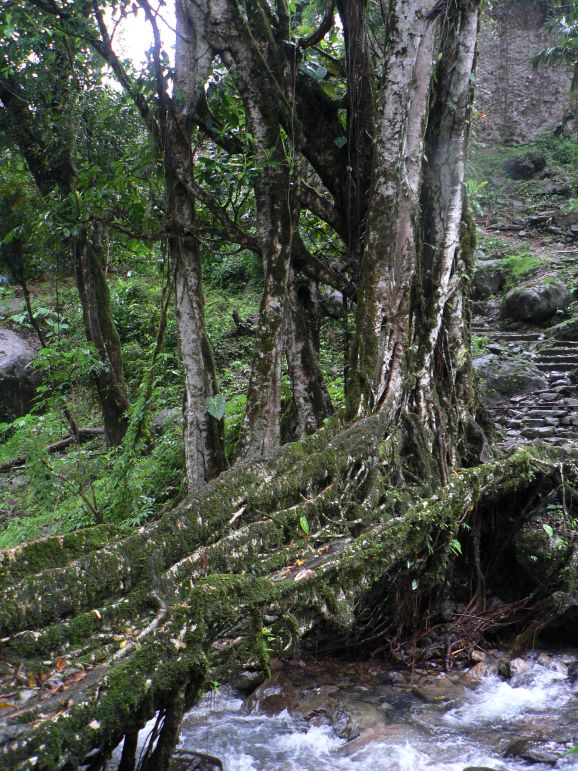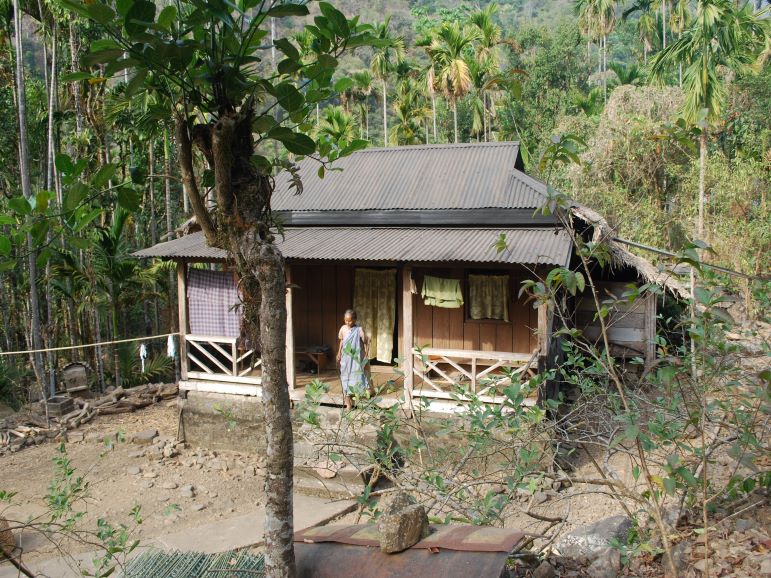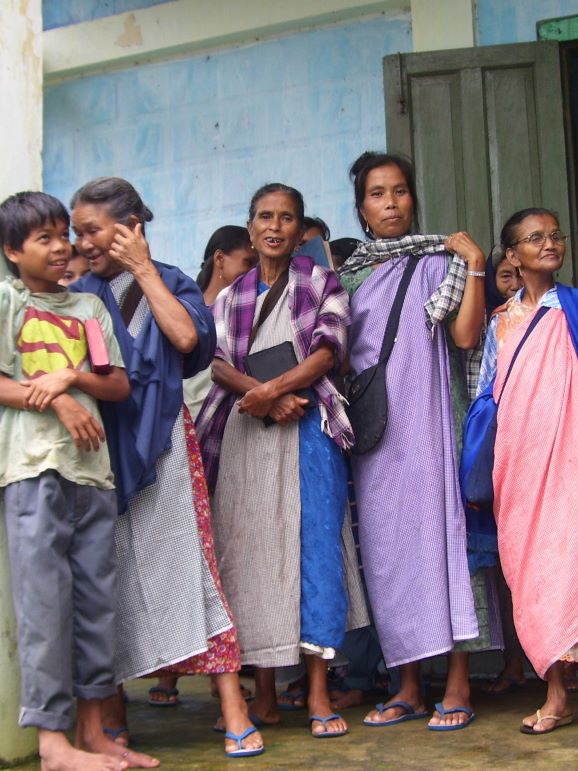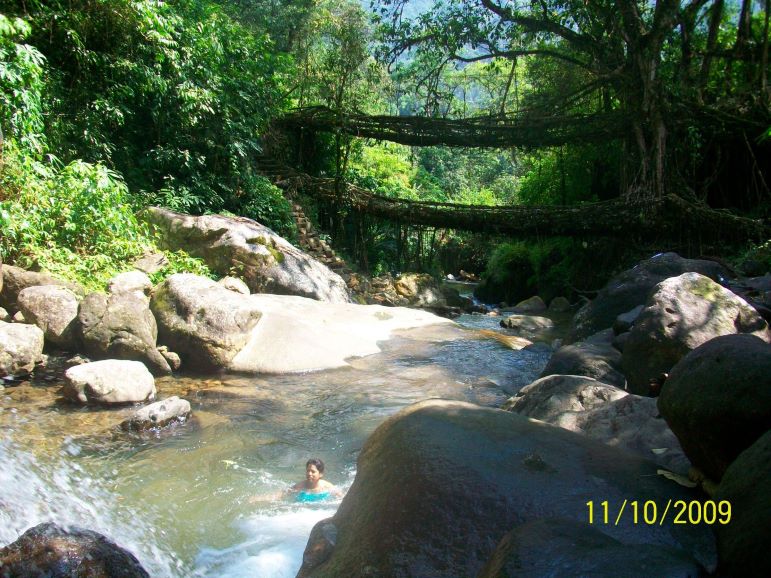Trail Of The Unexpected: The root masters of India
The extraordinary bridges over the Khasi river valleys are living works of art
By Jini Reddy
Saturday, 23 January 2010
I was in the wettest place on earth: Cherrapunjee, a region in the verdant, little-visited north-eastern Indian state of Meghalaya. Now, though, the skies were a clear, brilliant blue. I’d come to trek to Cherrapunjee’s mysterious living-root bridges. These structures are as much works of art as examples of environmentally friendly bio-engineering.

Living Root Bridge, Nongriat

Jini Reddy (right) with Carmela
“They’re Meghalaya’s Taj Mahal,” said Denis Rayen, the owner of the Cherrapunjee Holiday Resort, as we sipped cold drinks on the front lawn and watched a band of local musicians perform a medley of folk tunes and Bollywood favourites for the guests.
The six bridges are the creation of the tribe who live in the area’s isolated valleys: the Khasi. They, or rather their forefathers, dreamt up the idea of coaxing the roots of the Ficus elastica tree (otherwise known as the Indian rubber tree) along hollowed-out trunks of betel palm and bamboo in order to cross rivers.
…. Continued after the Menu.
The bridges take 25 years or so to become functional, but they can bear the weight of up to 50 people at a time, and last for five centuries or more.
They’re also well hidden. Rayen, a former banker from Chennai who married a woman of Khasi descent, discovered the bridges for himself nine years ago, while building the resort.
I was exploring trekking routes and headed off with some villagers. I crossed a mountain stream on one and did a double-take,” he said. Recognising their potential appeal to tourists, he has since painstakingly mapped out hikes to the bridges. The most popular hike takes visitors to the Umshiang double-decker root bridge.
Getting to it takes dedication. The resort is the only place to stay for miles. It is 11 miles from Cherrapunjee town, high above the Khasi Hills which rise from the Bangladeshi plains to the south. The last leg of the journey is via a winding road overlooking magnificent ridges and gorges from which tumble frothy waterfalls. It is a picturesque reward for the six-hour drive from the airport over the border in the Assamese capital of Guwahati.
The next morning, I doubled back on the road to the small village of Tyrna, where the six-mile trail starts. From there it was a dizzyingly steep descent into the heart of a forested valley.
We passed through lush tropical vegetation and cliff-and-waterfall scenery; from time to time giant yellow butterflies danced around me and birds flitted about the treetops. All the while I was assailed by the heavenly scent of orchids and hibiscus flowers.
Nongthymai, a small farming village, started where the steps ended. A noticeboard outlined the village rules, which Peter translated for me: “No loitering after dark, no swearing, no alcohol, no litter, no graffiti, no washing under the public tap.” Indeed, the village was scrupulously tidy, the small plots of land around the homes neatly filled with potatoes, pumpkin and cauliflower.
The Khasi are predominantly Christian, as a result of the arrival of Welsh missionaries in the 19th century. As we trekked through the village, I didn’t spot a single Hindu shrine, deity, plume of incense, or tikka-foreheaded child. Rather than saris, the women wore the Jainsem, a toga-like swathe of cotton. It was slightly disconcerting: a snapshot of an India without the familiar visual clues.

Simtung Wire Bridge
Beyond the village, we walked through more forest along slippery, moss-covered boulders. Then it all got a bit Alice in Wonderland: more giant butterflies in rainbow colours; weird mushrooms jutting from the trees; a long, green caterpillar inching sedately across my path. Peter pointed out a black-and-yellow spider the size of a small plate.
We crossed fast-flowing streams on swaying steel suspension bridges and parallel to one of these I spotted three unfinished root bridges, connected by tiny islands.
But it was the 200-year-old double-decker root bridge I had come to see. After two hours, as we approached the village of Nongriat, there it was. The roots of a single tree crossed the river on two levels, like a mad piece of macramé crossed with a tangled beard, bits of seaweed and a hairy den of tarantulas. It’s a bridge for hobbits, not humans.
I walked gingerly across the top level, which spanned 70 feet, then the slighter shorter bottom one, careful not to get my foot stuck in a stray root. It didn’t collapse.
Why would the villagers build a bridge on two levels, I wondered. “Because they fancied it,” said Denis when I met him later. “There’s even a triple-decker bridge in the works.”
The Umshiang bridge overlooks a small waterfall and rock pool. After a swim, and a lunch of jadoh, a sort of pork biriani, I tried to imagine the bridge in the swirling mist and rain.
Suddenly, I saw a figure crossing it. Not a hobbit, just a mop-haired teen making his way to the next village. Cherrapunjee’s living root bridges might rival the rain for romance, but for the Khasi they’ll always be a practical, environmentally friendly means to get from A to B.
Travel essentials: Cherrapunjee
Getting there
The gateway to the region is Delhi, which is served daily from Heathrow by Air India, British Airways, Jet Airways and Virgin Atlantic. From here, connecting flights to Guwahati are operated by GoAir, JetLite and Kingfisher.
Getting around
Travel the Unknown (0845 053 0352; traveltheunknown.com) operates a range of North East India tours, including a six-day tour to the living root bridges for £500.





